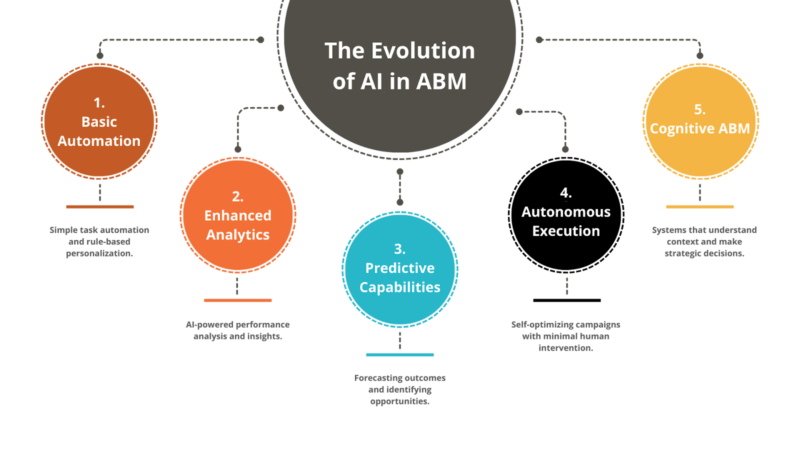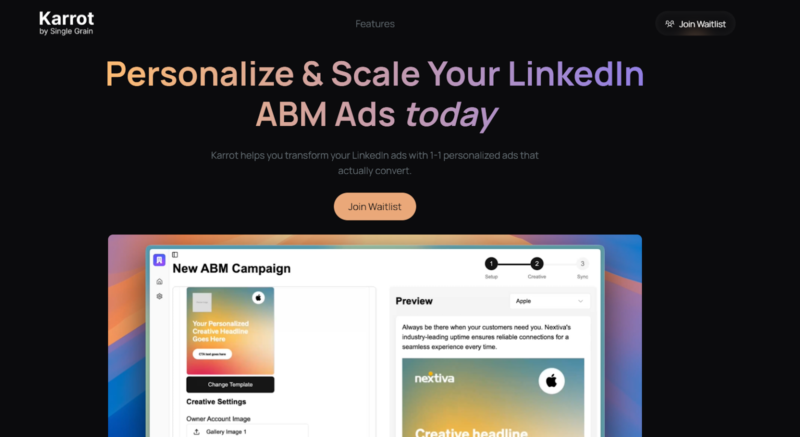Emerging Trends in AI-Powered ABM: What’s Next for LinkedIn Advertising
ABM marketers are under a lot of pressure. Various tactics, from hyper-personalization to multi-channel efforts, are required to execute a successful ABM campaign.
Fortunately, AI is shifting the way we do ABM. AI offers a data-driven approach to automating tasks and gaining accurate insights.
Here are emerging trends in AI-powered ABM and how marketers can use these predictions to boost their LinkedIn ad campaigns.
Key Highlights
- AI-powered LinkedIn ABM is projected to grow 215% over the next three years.
- 97% of marketers report that ABM delivers a higher return on investment than other marketing strategies.
- Hyper-personalization through AI is expected to improve conversion rates by up to 75%.
- Predictive intent modeling will transform how accounts are selected and prioritized.
- Autonomous optimization will enable self-adjusting campaigns that maximize performance.
- AI-powered tools like Karrot.ai are at the forefront of these transformative capabilities.
- Ethical AI considerations will become increasingly crucial in ABM implementation.
- Human-AI collaboration will define the most successful ABM programs.
TABLE OF CONTENTS:
The AI Revolution in LinkedIn ABM
We are entering a new era of AI-powered ABM that promises to enhance LinkedIn’s capabilities dramatically. Here’s more information on how this will affect ABM campaigns.
The Evolution of AI in ABM
AI offers more than efficiency–automation and predictive analytics make ABM more effective. The right tools provide data-rich insights and reduce the number of manual tasks marketers perform.

AI capabilities in LinkedIn ABM have evolved through several distinct phases:
- Basic automation: Simple task automation and rule-based personalization.
- Enhanced analytics: AI-powered performance analysis and insights.
- Predictive capabilities: Forecasting outcomes and identifying opportunities.
- Autonomous execution: Self-optimizing campaigns with minimal human intervention.
- Cognitive ABM: Systems that understand context and make strategic decisions.
Organizations implementing AI-driven insights into their content marketing campaigns generated 83% higher engagement rates. This improvement stems from the increased relevance, timing, and personalization that AI enables.
Trend 1: Hyper-Personalization at Scale
The next generation of personalization goes far beyond targeted messaging. Here’s how AI will scale hyper-personalized strategies.
Dynamic Content Generation
AI is transforming content creation for LinkedIn ABM in these ways:
- AI-generated messaging: Customized copy for different accounts and stakeholders.
- Dynamic creative assembly: Automated construction of personalized visuals.
- Real-time content adaptation: Materials that adjust based on recent account activities.
- Multivariate personalization: Simultaneous customization across multiple dimensions.
- Continuous optimization: Self-improving content based on performance data.
Contextual Personalization
AI enables more profound contextual relevance for these reasons:
- Business context integration: Personalization based on recent company developments.
- Individual context awareness: Customization based on stakeholder activities and interests.
- Relationship context adaptation: Content adjusted based on account relationship history.
- Competitive context: Messaging tailored to better position brands against competitors.
- Industry context alignment: Personalization reflecting sector-specific challenges.
The Karrot.ai Advantage

Platforms like Karrot.ai are pioneering hyper-personalization through:
- Natural language generation that creates human-quality personalized content.
- Computer vision technology that enables sophisticated visual personalization.
- Multi-dimensional personalization across numerous account attributes.
- Behavioral adaptation based on engagement patterns.
- Continuous learning that improves personalization effectiveness over time.
This AI-enhanced approach enables personalization depth and scale that would be impossible through traditional methods.
Trend 2: Predictive Intent and Opportunity Identification
AI is transforming how high-potential accounts are identified and targeted. Here’s a breakdown of how predictive analysis and intent data will improve the ABM process.
Advanced Intent Modeling
Intent models have been analyzing online activities and behaviors to predict consumer decisions. But next-generation intent detection capabilities will improve in these ways:
- Digital body language analysis: Interpreting subtle engagement patterns.
- Cross-platform intent synthesis: Combining signals from multiple sources.
- Temporal pattern recognition: Identifying time-based intent indicators.
- Stakeholder alignment detection: Recognizing buying committee formation.
- Competitive displacement signals: Identifying switch opportunities.
Opportunity Prediction
AI enables sophisticated opportunity forecasting in these ways:
- Conversion likelihood prediction: Forecasting which accounts will convert.
- Timing prediction: Anticipating when accounts will make decisions.
- Value prediction: Forecasting potential deal sizes.
- Competitive win prediction: Assessing the likelihood of competitive displacement.
- Resource requirement forecasting: Predicting effort needed for conversion.
This predictive capability ensures resources are allocated to opportunities with the highest potential return rather than spread across all accounts equally.
Buying Committee Mapping
AI is transforming stakeholder identification and mapping for more effective targeting. Here’s how:
- Role identification: Automatically identifying key decision-makers.
- Influence mapping: Determining relationships between stakeholders.
- Engagement sequencing: Identifying optimal order for stakeholder outreach.
- Objection prediction: Anticipating concerns from different roles.
- Champion identification: Recognizing internal advocates.
Trend 3: Autonomous Campaign Optimization
AI agents are becoming more intelligent and can work autonomously without human interference. Self-optimizing campaigns represent the next frontier of AI for many reasons.
Continuous Experimentation
AI enables perpetual testing and refinement:
- Automated A/B testing: Continuous comparison of different approaches.
- Multi-variate optimization: Simultaneous testing of multiple elements.
- Segment-specific experimentation: Different tests for different audiences.
- Performance-based adaptation: Automatic adjustment based on results.
- Learning transfer: Applying insights across campaigns and segments..
Dynamic Budget Allocation
Autonomous AI agents can better adapt to ABM elements that change dynamically, such as budget allocation. AI transforms resource allocation in these ways:
- Real-time performance monitoring: Continuous assessment of results.
- Opportunity-based reallocation: Shifting resources to the highest-potential accounts.
- Channel effectiveness optimization: Adjusting spend across different touchpoints.
- Timing-based adjustment: Modifying allocation based on temporal factors.
- Competitive response adaptation: Adjusting investments based on competitor activity.
This dynamic allocation ensures resources are continuously directed to their highest-value application rather than following predetermined allocations.
Autonomous Decision-Making
AI systems are increasingly making campaign decisions with greater accuracy. Here are examples of this in action:
- Targeting adjustments: Refining audience parameters based on response.
- Creative optimization: Selecting and modifying assets based on performance.
- Timing modifications: Adjusting campaign schedules for optimal impact.
- Channel mix refinement: Shifting emphasis across different platforms.
- Messaging adaptation: Evolving communication based on engagement data.
This autonomous capability enables campaigns to self-optimize in real-time without requiring constant human intervention, significantly improving efficiency and performance.
Trend 4: Conversational AI and Interactive Experiences
AI is transforming how accounts engage with LinkedIn ABM content on both a sales and marketing level. Here are ways to implement this technology into your ABM campaign.
Intelligent Conversational Experiences
Next-generation conversational AI will have more self-learning capabilities and advanced natural language understanding (NLU). Here are ways you can use it:
- AI-powered conversation ads: Dynamic dialogue with target accounts.
- Personalized interactive content: Experiences that adapt to user choices.
- Natural language understanding: Systems that comprehend complex queries.
- Contextual response generation: Answers tailored to specific situations.
- Conversation memory: Interactions that build on previous engagements.
Intelligent Content Recommendation
Since data analysis in AI is improving, it can better identify trends and target accounts with the right content. This transforms content journeys in these ways:
- Interest-based recommendations: Suggesting content based on demonstrated interests.
- Stage-appropriate guidance: Recommending materials aligned with the buying stage.
- Role-specific suggestions: Tailoring recommendations to stakeholder positions.
- Question anticipation: Proactively addressing likely concerns.
- Next-best-action determination: Guiding accounts through optimal journeys.
This intelligent guidance ensures accounts receive the most relevant content at each sales funnel stage rather than following predetermined paths.
Virtual Account Executives
AI is enabling sophisticated virtual representatives in these ways:
- Account-specific knowledge: Virtual executives with deep account understanding.
- Personalized engagement: Interactions tailored to individual stakeholders.
- 24/7 availability: Continuous engagement capability.
- Consistent experience: Reliable quality across all interactions.
- Human escalation: Seamless transition to human representatives when needed.
Trend 5: Integrated Cross-Channel Orchestration
AI is transforming how LinkedIn ABM coordinates with other channels. Here’s what ABM marketers should expect.
Unified Experience Orchestration
Next-generation cross-channel coordination offers:
- Cross-platform identity resolution: Connecting individuals across different touchpoints.
- Synchronized messaging: Consistent communication across channels.
- Channel sequence optimization: Determining which platforms should be the highest priority.
- Cross-channel attribution: Understanding how channels work together.
- Unified performance measurement: Comprehensive view of the campaign’s impact on goals and objectives.
Omnichannel Personalization
AI will improve consistent personalization across various channels in these ways:
- Cross-channel profile development: Unified view of account preferences.
- Format-adaptive personalization: Content that adjusts to channel requirements.
- Consistent personalization elements: Core customization across touchpoints.
- Channel-specific optimization: Personalization tailored to platform characteristics.
- Synchronized personalization updates: Consistent evolution across channels.
This omnichannel approach ensures accounts experience consistent personalization regardless of where they engage, rather than disconnected experiences across platforms.
The Karrot.ai Cross-Channel Advantage
Platforms like Karrot.ai are pioneering integrated orchestration. Karrot.ai is designed to grow your brand on individual platforms, increasing engagement and driving sales among accounts. Here’s how it works:
- Cross-channel identity management that connects individuals across platforms
- Centralized personalization engine that ensures consistency across touchpoints
- Channel-specific adaptation that optimizes for different platforms
- Unified analytics that provide a complete view of performance
- AI-powered coordination that orchestrates the entire account experience
When you integrate Karrot.ai into your ABM strategy, you create synchronized experiences across all your marketing channels.
Trend 6: Ethical AI and Privacy-Centric Approaches
As AI capabilities advance, ethical considerations become increasingly important, especially regarding privacy. Here’s what to know.
Privacy and Personalization
Next-generation AI balances personalization with privacy by saving as little data as possible. Here’s what ABM marketers should expect:
- Consent-based personalization: Customization based on explicit permissions.
- Anonymized pattern recognition: Insights without individual identification.
- On-device processing: Local data analysis that preserves privacy.
- Federated learning: Model improvement without centralized data collection.
- Transparent data usage: Clear communication about information utilization.
Privacy-centric approaches will become increasingly crucial as regulations evolve and customer expectations change.
Ethical AI Frameworks
There are emerging standards for using and managing AI in ABM responsibly. These include:
- Bias detection and mitigation: Identifying and addressing algorithmic biases.
- Human oversight integration: Appropriate human involvement in key decisions.
- Value alignment mechanisms: Ensuring AI systems reflect organizational values.
- Continuous ethical evaluation: Ongoing assessment of AI’s impact.
These ethical frameworks ensure AI systems operate responsibly rather than pursuing objectives without appropriate constraints.
Trust-Building Approaches
Strategies for maintaining customer confidence include:
- Transparency in AI usage: Clear communication about how AI is employed.
- Value exchange clarity: Explicit benefits provided in return for data.
- Control mechanisms: Giving accounts influence over their experience.
- Data minimization: Collecting only essential information.
- Purpose limitation: Using data only for intended purposes.
More consumers are becoming increasingly selective about which organizations they engage with. Putting trust at the forefront will make you more competitive.
Trend 7: Human-AI Collaboration Models
In addition to implementing strong security measures, human employees will collaborate more with AI rather than automation replacing labor. Here’s how it will work.
Augmented Intelligence Frameworks
Models for effective human-AI collaboration include:
- AI-assisted targeting: Algorithmic recommendations with human decision-making.
- Collaborative content creation: AI-generated drafts with human refinement.
- Guided optimization: AI-identified opportunities with human implementation.
- Insight surfacing: AI-discovered patterns for human interpretation.
- Exception handling: Human intervention for complex or sensitive situations.
This collaborative approach combines AI efficiency with human judgment, creating results superior to either working independently.
Skill Evolution Requirements
Changing capabilities needed for ABM professionals include:
- AI literacy development: Understanding AI capabilities and limitations.
- Prompt engineering skills: Effectively directing AI systems.
- Output evaluation abilities: Assessing AI-generated content and recommendations.
- Strategic oversight capabilities: Providing direction to AI systems.
- Ethical judgment application: Making value-based decisions about AI usage.
These skills ensure marketing professionals can effectively leverage AI rather than being replaced by it.
Organizational Transformation
Here’s how companies must evolve to leverage AI effectively:
- Process redesign: Workflows optimized for human-AI collaboration.
- Role redefinition: Job descriptions that incorporate AI interaction.
- Training programs: Skill development for AI collaboration.
- Performance metrics: New measures that reflect augmented capabilities.
- Cultural adaptation: Mindsets that embrace AI as a partner.
This ensures companies fully capitalize on AI capabilities rather than simply adding technology to existing structures.
Case Study: Future-Forward Company Embraces AI-Powered ABM
A forward-thinking B2B technology company implemented next-generation AI capabilities for their LinkedIn ABM program targeting 2,000 enterprise accounts. By embracing emerging trends, they:
- Deployed hyper-personalization at scale using Karrot.ai’s advanced capabilities.
- Implemented predictive intent modeling to identify high-potential opportunities.
- Utilized autonomous optimization for continuous campaign improvement.
- Integrated conversational AI to create interactive account experiences.
- Established cross-channel orchestration for unified customer journeys.
- Adopted ethical AI frameworks to ensure responsible implementation.
- Created effective human-AI collaboration models across their marketing team.
The results demonstrated the power of next-generation AI:
- 215% increase in target account engagement compared to traditional approaches
- 78% improvement in MQL-to-opportunity conversion
- 42% reduction in cost-per-acquisition
- 4.7X return on ad spend (up from 2.2X with conventional methods)
- $32.8M in influenced pipeline within 6 months
- 85% of sales team members reported significantly higher quality conversations
Preparing for the AI-Powered ABM Future
To position your organization for success in LinkedIn ABM, consider these strategic recommendations:
- Assess your AI readiness with a comprehensive capability evaluation
- Develop a phased implementation roadmap for advanced AI capabilities
- Invest in data foundation improvements to support sophisticated AI
- Pilot emerging capabilities in controlled environments before scaling
- Build cross-functional AI literacy across marketing, sales, and IT
- Partner with leading AI providers like Karrot.ai to access cutting-edge capabilities
- Establish ethical guidelines for AI implementation before deployment
- Create feedback mechanisms to continuously evaluate AI’s impact
- Develop talent strategies that prepare your team for human-AI collaboration
- Maintain a learning orientation as AI capabilities continue to evolve
Expect These Emerging Trends in AI-Powered ABM
AI has improved many aspects of ABM, such as identifying, engaging, and converting high-value accounts. However, all marketers should expect many emerging trends in AI-powered ABM.
From hyper-personalization and predictive intent modeling to autonomous optimization and conversational experiences, these emerging trends represent a fundamental evolution in what’s possible in ABM. Since predictive analytics and automation will offer more effective ABM strategies, marketers can focus on strategy and creative tasks that will improve ROI.
Balancing innovation with targeted messaging is the key to implementing the latest AI technology in ABM. Develop human capabilities to collaborate with increasingly powerful AI systems.
Tools like Karrot.ai can help you personalize content to individual accounts and segments, automating relevant messaging and targeting.




